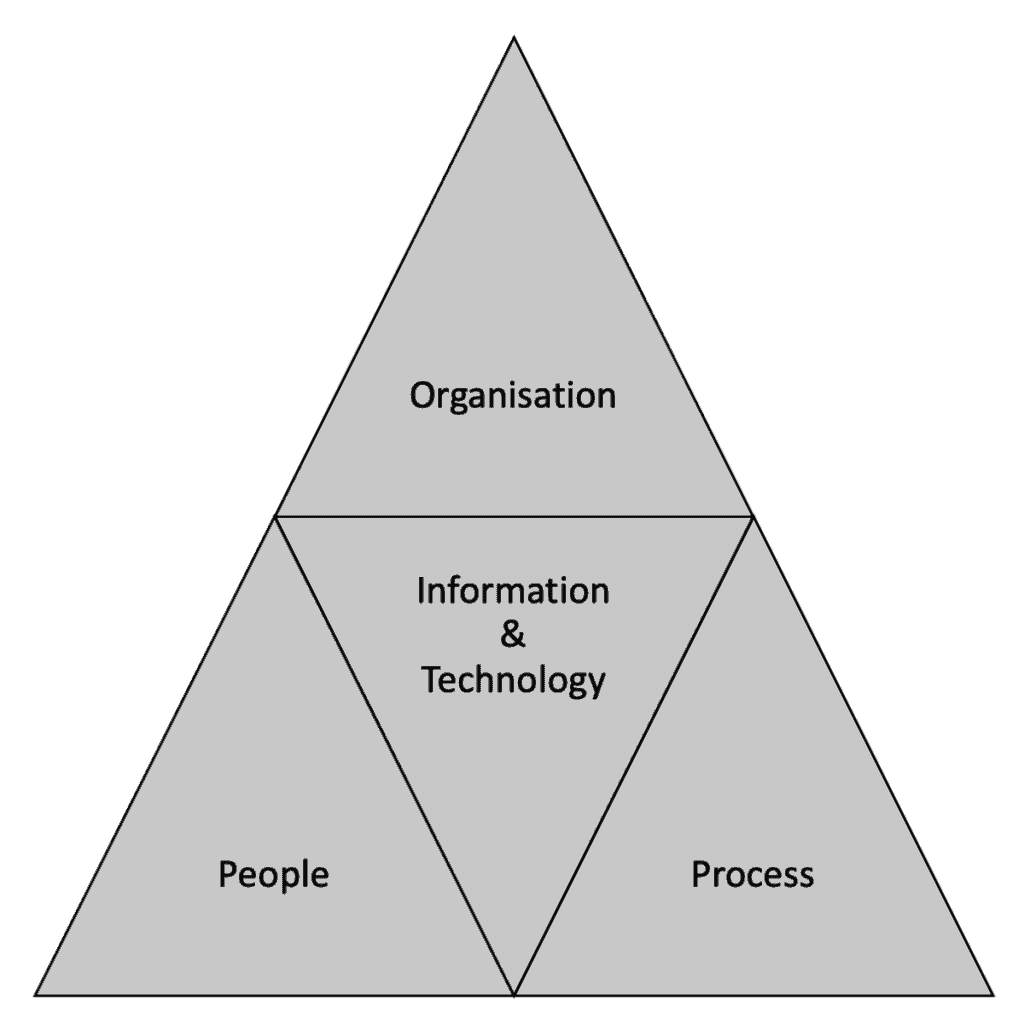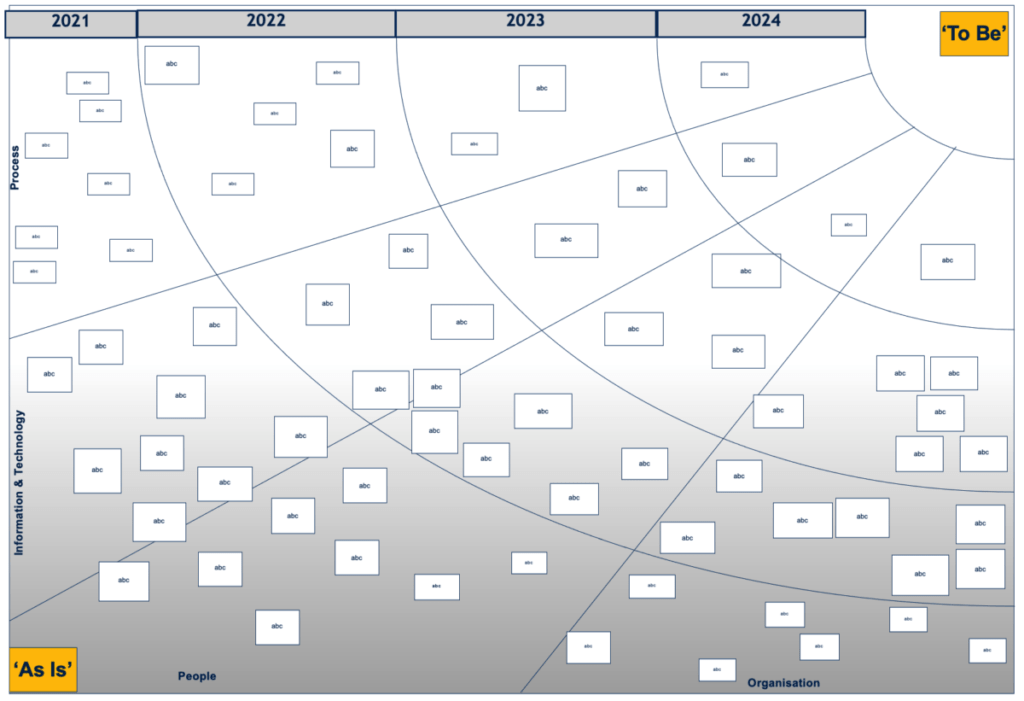POPIT Model – What Does POPIT Stand For?
The POPIT model provides a useful perspective to consider needs, opportunities and desired changes to solve business problems. POPIT stands for Process, Organisation, People, Information and Technology. Sometimes the POPIT model is referred to as the four-view model and abbreviated to Process, Organisation, People and Information Technology.

Table of Contents
More than often, especially on digital transformation programmes and initiatives, there is a focus on technology to solve a business problem, with some projects proceeding on this basis. But as the project progresses, especially in a complex domain, it will soon become apparent that introducing a technology solution may have an impact and implications on the process, organisation, people and information.
Having the POPIT model in mind as a business analyst provides a useful holistic checklist reference guide to consider, as you carry out your business analysis activities during current state analysis (AS-IS) and future state analysis (TO-BE).
Taking a holistic approach is even more important when it comes to digital transformation
The POPIT model is also a useful reference when deploying or transitioning a technology solution and considering the associated impacts. For example,
- Process – have the process maps or operational procedures been updated?
- Organisation – has the organisational structure been updated; or is a new department or function needed?
- People – have the operational staff impacted by the change been consulted and trained?
- Information – what information is needed to support and solve the business problem? Are there any legislation information needs which governs the operational use of the information? Are there any retention policies or archiving consideration of the information?
- Technology – What applications, hardware, software is needed to support the deployed technology solution.
Using the perspective of the POPIT model helps to have better alignment of the change, needs, solution, stakeholder, value, and context
POPIT Model – Process
When conducting current state analysis (AS-IS) it is typical to review and understand the current business processes to understand the business context and provide a basis for understanding where needs, problems and opportunities reside. If the business processes don’t exist? The business analyst may need to consider documenting to gain this business context.
When working on the future state analysis (TO-BE) the future state business process can be determined that provide a basis for understanding how the technology solution will operate alongside the future state business processes.
For the future state business processes, it is important that the business processes provide value to support the customer and any waste is eliminated to help ensure that the process is as streamlined as it can be.
The future state business process map also provides a vehicle whereby operational staff can be trained on the new operational processes and ways of working.
POPIT Model – Organisation
In complex change initiatives, it is typical to consider an organisational perspective and understand the current organisational structures and organisational reporting lines.
In more complex change initiatives, the organisational structures or reporting lines of operational staff may need to change. New job designs, job descriptions, roles and responsibilities may be needed to support the change.
The organisational changes should also consider business as usual (BAU) activities such as dealing with customer calls or dealing with operational issues and activities to keep the operational service running to the expected level of measurable performance.
POPIT Model – People
When you consider that only a few individuals sit at the very top of corporate organisations, their experiences of and contribution to change initiatives sometimes occurs several weeks, months or even years of the initiative starting.
Some people will operate in parts of an organisation where their day-to-day work is dominated by issues about their task, department, division or project team.
It is important to consider the people aspects of change and its associated emotional implications. The SARAH model
To aid with understanding the people considerations, it is useful to understand the different types of operational roles that are supporting the business processes. It may be necessary to shadow the people involved with the change to understand their perspective of issues and pain points and more importantly listen to understand their issues, needs and seek out opportunities for improvement.
Sometimes there may be the need for a people strategy; leadership development, workforce development and skills and training needed to support the future state (TO-BE).
The knowledge and experience of people can be the key factors enabling the success of business strategies. But they can hinder the successful adoption of new business strategies too. Understanding the cultural impacts will help with providing a smoother transition of change to people and by inviting them rather than inflicting change to them.
From a customer perspective, there may be the need to establish a set of personas to help provide and support a customer centric perspective and help understand customer pain points, gains and jobs that need to be done.
POPIT Model – Information
Having a current state (AS-IS) understanding of how information is supporting the business context is an important consideration.
More importantly when determining and working on the future state (TO-BE), determining what new types of information is required to support and create opportunities in the new ways of working is equally important.
New information needs can be identified that enable operational processes to run more effectively or provide more purposeful or enhanced customer missions, such as providing more information to help with customer purchases; or by enriching information to provide the necessary legislation information to support the customer from a health and safety perspective.
The quality, accuracy and completeness of the information is important; so is understanding who is responsible for creating and maintaining the information. In addition, information retention and archiving needs have to be considered.
Knowledge creation (by finding trends, patterns, connections in the information) and information management are issues confronting organisations as potential sources of improved competitiveness. From a strategic perspective the key is the extent to which improvements in information processing capability can improve and assist the way in which knowledge is created and shared both within and around an organisation.
POPIT Model – Technology
In the current state (AS-IS) there is sometimes the need to understand what applications, hardware, software is supporting the current state and determine what technology gaps there are.
The technology gaps are often the ones that may require enhancements or replacement to support the future state (TO-BE).
The POPIT model is most useful as a reference point to check when any technology is being planned for deployment to check whether the other elements of the model (i.e., process, organisation, people, information) have been updated and also ready and available to support the technology deployment.
Transformation Map
The POPIT model also provides a useful framework to support and determine a transformation delivery plan/map.
By using elements of the POPIT model, process, organisation, people, information and technology and by establishing the current state (i.e., the starting point of the plan) and a future state (i.e., the desired state of the plan) – key milestones can be plotted, and alignment can be established amongst the projects that make up the projects and programmes needed to meet the strategic objectives and vision to meet the business outcomes.
Such a perspective and transformation delivery plan/map also provide a basis for measuring progress and adapting the plan and work-streams as they move and transition from the current state to the future state.

Conclusion – POPIT Model
The POPIT model is helpful for business analysts for conducting current state and future state business analysis activities.
By taking a holistic perspective of the POPIT model – the process, organisational, people, informational and technology problems, needs, opportunities and requirements can be considered to help in the areas of providing an aligned business solution, transformational change management.

